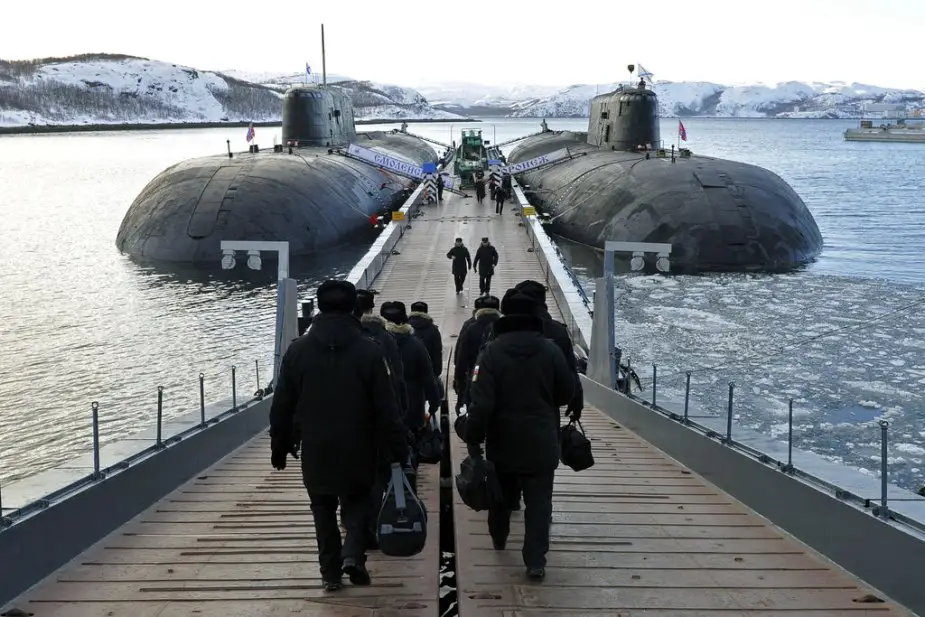Analysis: Russia completes first stage of submarine infrastructure upgrade
The Russian Defense Ministry is completing the first stage of infrastructure modernization for submarines. For the first time in modern history, Russian submarines will have protected bases and berths with the necessary equipment, the Izvestia daily writes.
 Nuclear-powered submarines at a base in Russia’s Murmansk region. Moscow has increased submarine patrols in the past year (Picture source: Lev Fedoseyev/TASS)
Nuclear-powered submarines at a base in Russia’s Murmansk region. Moscow has increased submarine patrols in the past year (Picture source: Lev Fedoseyev/TASS)
The first stage designed ground infrastructure, shelters and life-support systems. Navy sources said their construction in Gadzhievo and Zaozersk in Murmansk region and Vilyuchinsk in Kamchatka has begun.
A modern submarine is the most sophisticated and high-tech military vehicle. All conditions are necessary for its long operation. In a base, a submarine needs electricity, compressed air, steam, etc. There should be arsenals to keep missiles and torpedoes and berths and cranes to load ballistic missiles.
In 2012, the Navy command decided to develop green-water fleet and focused on infrastructure for warships and submarines.
Today Russia runs four submarine construction programs. The first comprises Borey-A-class SSBN of project 955A. Two of them - the Knyaz Vladimir and the Knyaz Oleg - will join the Navy this year. The second program relates to Yasen-M-class SSGN of projects 885 and 885M. The fourth-generation submarines are armed with various missiles and torpedoes, including Kalibr missiles. They are the most sophisticated and high-tech arms. The third program includes Lada-class diesel-electric submarines of project 677. The fourth relates to diesel-electric subs of project 636.3.
The Soviet Union preferred to build warships rather than infrastructure. Submarines were moored and their systems worn out ahead of time. The short life cycle of project 705 is an example. They were the speediest submarines in the world fleet. The small, well-armed and highly automatic submarines made a sensation in 1970-1980s. However, they were powered by a reactor with liquid crystal heat exchanger. Unfortunately, maintenance problems with the reactors decreased the life cycle of project 705. Poor infrastructure committed to scrap a bug number of warships and submarines in the 1990s which could be operational until now.
The sad experience made the Navy command to begin with the design of proper infrastructure. The first stage has been completed in Vilyuchinsk. The second stage has to move close to a million cubic meters of soil. A complete new base will be created.
A lot of work has been done to create a naval base in Syrian Tartus. It is now a full-fledged base which can accommodate nuclear and non-nuclear submarines.
The Navy received a big number of harbor tugs to take submarines into the ocean. The Akademik Korolev arms transport ship ensures the activities of the submarine command of the Pacific fleet. The Akademik Makeev is being built for the Northern fleet. The construction of a protected dock to load ballistic missiles is nearing completion in Vilyuchinsk.
In case of a war, the Navy will hide the fleet in numerous bays. Various auxiliary vessels are necessary for that.
Housing and everyday utilities were built in submarine deployment places in the Kola and Kamchatka Peninsulas. The multilayered defense was created against underwater subversion forces. Each base is guarded by a countersubversion team. S-400 and Pantsir regiments provide air defense to the bases.
Submariners have to constantly train survivability. Training centers operate for that. The Navy command pays specific attention to training and retraining of submariners, the Izvestia said.
© Copyright 2020 TASS. All rights reserved. This material may not be published, broadcast, rewritten or redistributed.


























